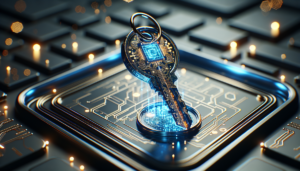Have you ever stopped to think about just how much of your life exists online? From social media profiles to banking information, our digital footprints seem to grow larger by the day. This brings me to a critical topic that affects all of us in today’s interconnected world: cybersecurity.
Understanding Cybersecurity
When I think about cybersecurity, I realize it’s more than just a buzzword floating around in tech circles. Cybersecurity is the practice of protecting systems, networks, and programs from digital attacks. These attacks typically aim to access, change, or destroy sensitive information. It’s like having a sturdy lock on my front door to keep unwanted guests from entering my home.
The Growing Importance of Cybersecurity
As I navigate through my daily activities online, I see our reliance on technology only increasing. With businesses digitizing their operations and individuals managing almost every aspect of life online, the importance of cybersecurity has become more pronounced. Just think about the sensitive data that’s out there: Social Security numbers, bank account details, personal emails, and even medical records. The potential for this information to land in the wrong hands can have dire consequences.
Statistics that Reflect the Need for Cybersecurity
Feeling the weight of this issue, I often turn to statistics for a clearer picture. According to recent reports, cybercrime is projected to cost the world $10.5 trillion annually by 2025. That’s a staggering figure! Each day, individuals and businesses become victims of various cyber threats, from data breaches to ransomware attacks. By looking at these numbers, it’s hard not to take cybersecurity seriously.
| Year | Projected Cost of Cybercrime (trillions) |
|---|---|
| 2020 | $3.5 |
| 2021 | $6.0 |
| 2022 | $8.0 |
| 2023 | $10.5 |
The graphs paint a worrying picture, making it evident that everyone needs to step up their cyber defenses.
Common Cyber Threats
As I delve deeper into the realm of cybersecurity, I encounter various types of cyber threats. Understanding these threats enables me to better protect myself and my assets.
Phishing Attacks
One of the most malicious forms of cybercrime I have come across is phishing. In a phishing attack, cybercriminals attempt to deceive individuals into revealing sensitive information through seemingly legitimate emails or messages. A couple of deceptive tricks can lure me into clicking a malicious link or providing my personal data.
Ransomware
Ransomware is another term that keeps popping up when I research cybersecurity. It’s a type of malware that threatens to publish a victim’s data or block access to it unless a ransom is paid. I’ve seen numerous reports of businesses being crippled by such attacks, forcing them to pay hefty sums to regain access to their systems.
Data Breaches
Data breaches happen when unauthorized individuals gain access to sensitive data. From my perspective, this is particularly terrifying because it means that my information is at the mercy of hackers. According to a report from IBM, the average cost of a data breach in 2021 was a staggering $4.24 million. That’s a wake-up call for all of us.
Insider Threats
Interestingly, insider threats are another area that I think we need to scrutinize. These threats come from within an organization, either due to malicious intent or reckless behavior by employees. This dual nature makes insider threats particularly hard to guard against.
The Consequences of Cyber Attacks
The ramifications of a cyber attack can ripple through various aspects of life—personal, professional, and economic.
Financial Loss
For me, the most immediate consequence of a cyber attack is financial loss. Individual victims may lose money due to stolen credit card information. Businesses can face substantial financial hit due to data breaches, lawsuits, and the costs involved in remediation efforts.
Reputation Damage
In addition, the reputation of a company can suffer dramatically. If a business I trust gets hacked, it may cause me to second-guess whether I want to continue my relationship with them. Rebuilding trust in such situations is a long and arduous process.
Legal and Regulatory Issues
Cybersecurity isn’t just an individual concern; it’s also a legal matter. There are various laws and regulations I need to be aware of. For example, companies that suffer data breaches may need to notify affected customers and regulators, leading to legal consequences if they fail to do so.
Operational Disruption
I can’t ignore the operational disruptions that can stem from a cyber attack. When businesses are forced to shut down operations temporarily to deal with a breach, it can have a cascading effect on revenue, customer service, and employee productivity.
Best Practices for Cybersecurity
Now that I’ve painted a picture of the threats and consequences, I find it crucial to discuss best practices for cybersecurity. Implementing certain strategies can empower both me and organizations to bolster our defenses.
Strong Passwords
Despite the convenience of using simple passwords, I know that strong passwords are my first line of defense. Each account should have a unique password that combines upper and lowercase letters, numbers, and special characters. I often use a password manager to keep track of my passwords securely.
Multi-Factor Authentication
Multi-factor authentication (MFA) adds another layer of security by requiring not just my password but also something I have (like my smartphone) or something unique to me (like a fingerprint). Enabling MFA whenever possible is a step I take to significantly enhance my security.
Regular Software Updates
Software companies regularly release updates to patch security vulnerabilities. I find it essential to install these updates promptly—it’s like fixing a broken lock before someone tries to break in.
| Action | Frequency | Importance |
|---|---|---|
| Change passwords | Every 3-6 months | Prevents unauthorized access |
| Update software | Monthly | Fixes security loopholes |
| Backup data | Weekly | Safeguards data against loss |
Employee Training Programs
For organizations, I believe investing in employee training programs can raise awareness about cybersecurity threats. Employees are often the first line of defense, and teaching them about phishing and data protection significantly reduces vulnerabilities.
Data Encryption
When I consider data protection, encryption is a powerful tool. Encrypting sensitive data—both in transit and at rest—ensures that even if hackers gain access to the data, they won’t be able to read it.
Closed Networks and Firewalls
Setting up firewalls and closed networks is like creating a fortress around digital assets. I see this as an essential practice for organizations to control incoming and outgoing network traffic.
Future Trends in Cybersecurity
The landscape of cybersecurity is constantly evolving, and I find it fascinating to consider future trends.
Artificial Intelligence and Machine Learning
I can foresee artificial intelligence (AI) and machine learning playing increasing roles in detecting and mitigating cyber threats. These technologies analyze data and identify suspicious activities much faster than a human could.
Cloud Security
As more individuals and companies rely on cloud services, the security of cloud environments becomes paramount. I anticipate an increased focus on secure cloud configurations and robust access controls.
Cybersecurity Regulations
Regulatory frameworks are likely to become more stringent. I think it is essential for organizations to brace themselves for new laws that will mandate higher cybersecurity standards in place.
Conclusion: Taking Cybersecurity Seriously
Reflecting on everything I’ve learned about cybersecurity, I realize that it’s not just a concern for IT professionals; it’s relevant to everyone. In today’s digital landscape, where technology is intertwined with our daily lives, being proactive about cybersecurity is crucial for protecting my personal information, my finances, and my peace of mind.
Just like I wouldn’t leave the front door to my home wide open, I will continue to take steps to safeguard my digital life. I encourage everyone to join me in valuing cybersecurity as an essential part of our daily routines. The digital world may be vast and ever-changing, but our commitment to security can help us navigate it safely.






